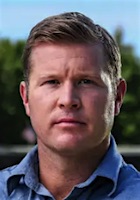14 July 2023 — 0515 mdt
Push Digital pushed Lindsey, Cindy, Marco, Trey, & Chuck
Tim Sheehy should fire his blundering
South Carolina based campaign consultants
By James Conner

Tim Sheehy
Republican senate candidate Tim Sheehy’s great weakness is his profound dearth of experience in electoral politics. That leaves him heavily dependent on Steve Daines and the national Republican senatorial campaign committee in choosing campaign consultants, and on those consultants after he chooses them.
To build his campaign website, and probably to do much more, he chose www.pushdigital.com, a full service political consultancy in South Carolina. Among Push’s clients are — the names are splashed atop the firm’s home page — nationally prominent Republicans Sen. Lindsey Grayham, SC; Sen. Marco Rubio, FL; former Rep. Trey Gowdy, SC; Sen. Chuck Grassley, IA; and Sen. Cindy-Hyde Smith, MS.
That’s an impressive list of, except for Iowan Grassley, southern politicians. One can see how hiring Push may have seemed a good idea. The firm’s description of itself eschews humility: “The place where the most talented team in politics shapes the future of digital communication.”
“Fundraising. We raise more money than ANYONE – $135 million for our clients in 2020 alone. As a fully-integrated digital agency, we have the tools and talent to help our clients win, including strategy, email, text, list management, and web services.”
“Production. Our in-house team of designers, developers, and videographers produce award-winning creative year after year. When it comes to branding, websites, and video storytelling, we’re the best in the business.” [Italics added.]
So what kind of website did the best in the business build for Sheehy?
According to Business Insider, one featuring photographs not taken in Montana. A photo intended to illustrate Sheehy’s Montana cattle ranch was taken in Kentucky.
An original copy of the photo can be found on the Shutterstock page of Patrick Jennings, a Kentucky-based photographer. A similar photo on the website indicates that the picture used by Sheehy was taken in a field in Kentucky.
♦ ♦ ♦ ♦ ♦
The photo that Sheehy originally used to illustrate his support for border security was taken in Russia, while a photo in his “Forest Management” section originates from Ukraine.
Reached for comment, Sheehy campaign spokeswoman Katie Martin blamed their campaign’s digital vendor, Push Digital, for the “unfortunate error.”
Yes, Push is responsible for its blunder. But so is Sheehy, for he clearly did not instruct his staff to make damn sure all the photographs were taken in Montana, or in the case of the border with Mexico, at the Mexican border. Sheehy trusted, but didn’t verify. He may also have ordered building the website on the cheap (the truly best in the business would refuse to do that).
Still, this should not have happened.
Push had to know that as soon as the website was available to the public, Jon Tester’s opposition research operation (oppo) would scrutinize it with a microscope, using reverse image search technology to identify the content and source of each photograph. That’s undoubtedly what happened, and I have no doubts that Tester’s campaign tipped Business Insider to Push’s blunder. That’s how the game is played.
And Push, its strutting self confidence notwithstanding, knows that’s how the game is played. So why did it not make sure that the cattle and trees were photographed in Montana, and that the Mexican border fence was Trump’s hideous black steel picket barrier? This campaign will cost tens of millions of dollars. How much would it have cost to hire a photographer to take authentic photographs of Montana and Trump’s wall (which Mexico still hasn’t paid for)?
Why? Because it’s not the best in the business. It just thinks it is. And that’s proof that those whom the gods would destroy they first make proud.
Sheehy’s giving Push hell won’t change Push’s culture. If he sticks with the firm, its hubris will lead to blunders that mortally wound his campaign instead of just embarrassing it.
His best option: pushing Push out of his campaign. Pronto.
Then he should consider doing some reading about politics and campaigning. One place to start: Tip O’Neill’s entertaining autobiography, Man of the House: The Life and Political Memoirs of Speaker Tip O’Neill (1988). Tip, old political pros remember, said all politics is local. He was right.
This could happen to careless candidates of both parties
Let’s start with four simple propositions:
- All images in a candidate’s advertising/propaganda should be in-district or directly related to the district (the candidate meeting with the governor, for example).
- A campaign should do its own photography. It should not use stock agency images or images scraped from the internet.
- A campaign’s images, like words, should present information relevant to the candidate. They should not be eye candy.
- Candidates should trust, but verify, and be especially on their guard when working with ad agencies and graphic designers who know nothing about their districts and who use stock images almost automatically.
These are not unreasonable rules. I observed them easily when preparing advertisements and literature for candidates.
